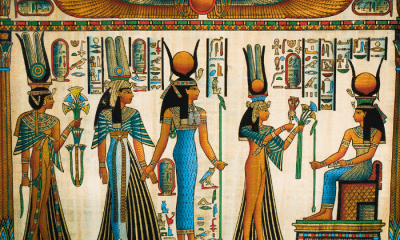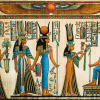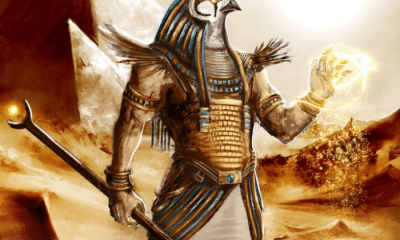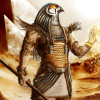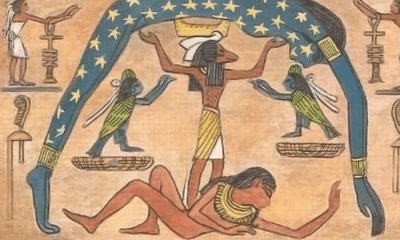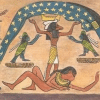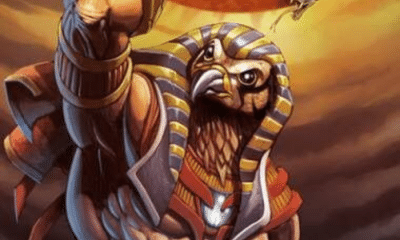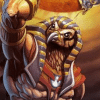
Egyptian
Who Was Set in Egyptian Mythology?
Who Was Set in Egyptian Mythology?
The god Set is often seen as an evil figure in Egyptian mythology, but did you know he was also a protector? Keep reading to find out more about the Egyptian god of deserts, storms, and foreigners!
In Egyptian mythology, Set was the brother of Osiris.
The two were almost exact opposites. Osiris was the king of Egypt and represented its culture and agriculture, while Set was the wild, chaotic god of the desert.
Set’s most famous myth is that of his brother’s death. After killing Osiris, Set took his throne.
Osiris had an heir after his death, however. Set’s battle with Horus and hatred of Osirus would eventually lead to a tradition in which he was rehabilitated and took on a more benevolent form.
This identification did not last in Egyptian culture, however. As the country became weaker and more fractured, Set’s association with foreign peoples would make him a hated symbol of Late Period Egypt’s rulers.
The Family of Set
Set was born to Geb, the earth god, and his sister-wife Nut, the goddess of the sky.
Ra had cursed Nut to never be able to have a child on any of the calendar days. When Thoth won five days worth of moonlight in a board game, however, he added these days onto the end of the year to keep the solar and lunar years in sync.
Because these five days were not part of the year, Nut was able to have a child on each of them. These were Set, Osiris, Isis, Nephthys and, in some versions of the story, the first Horus.
According to some legends, Set’s association with disorder and chaos was evident from birth. In one version of the story, Nut spit him out, while in another he tore his way out of his mother’s womb.
Many later sources claimed that Set had married his sister Nephtys shortly after they were born. This appears to be largely unmentioned in Egyptian writings, however, and may have been added by later writers to add symmetry to the pairing of Osiris and Isis.
Most of Set’s mythology would similarly paint him as the opposite of his regal brother. While Osiris represented the bounty and culture of Egypt, Set was the god of the harsh desert, chaos, and foreigners.
An Unusual Animal
Even Set’s iconography set him apart as a force of disorder.
The Egyptian gods were often associated with specific animals. One Greek writer claimed that so few animals lived in the Egyptian desert that every one was considered sacred.
Horus had the head of a falcon, Bast was the cat goddess, and Anubis was the jackal. Other gods, like Osiris and Isis, were usually shown as human but had sacred animals in their temples and legends.
Set was also shown with the head of an animal, but he was the only Egyptian god whose form could not be easily identified.
Egyptologists call this creature the Set Animal and its origins and meanings are a topic of academic debate.
The Set Animal is sometimes said to resemble an aardvark. It has a similarly elongated nose that curves slightly downward.
Other features, however, are enigmatic. The Set Animal has large, erect, and squared-off ears that are not clearly inspired by any known animal.
Set is often depicted with a human body, but when the Set Animal is shown in its entirety its identification becomes even more difficult.
It has a slender canine body, reminiscent of a jackal or greyhound. Its tail, however, does not resemble any known dog.
The tail is long and held fully erect. At its end it is forked, a feature unfamiliar to similar animals in nature.
Some Egyptologists believe that this forked tail may have once been shown with a turf of hair instead. They believe the Set Animal was inspired by a jackal or wild dog but that its form was changed to distinguish it from Anubis.
This is in keeping with the theory that Set was a regional desert god who was incorporated into the pantheon after most of the other gods. His form became unrecognizable because another god, Anubis, was already shown as a desert jackal.
Others, however, believe that Set’s animal form is a chimera. Some elements are taken from known creatures that live in the Egyptian desert while others are purely imagined.
If that is the case, Set would be the only god in the Egyptian pantheon to be widely shown as a chimera. In contrast with the familiar forms of the other deities, this could have been a way to illustrate his uncivilized and chaotic personality.
Set and the Murder of Osiris
Set’s most famous myth involves his violence against both his brother Osiris and his nephew, Horus.
Osiris inherited the crown from Geb, who in turn had inherited from Ra. As the younger brother, however, Set was always jealous of Osiris’s power.
Egyptian mythology makes it clear that Set murdered Osiris. Because writing was considered magical in the Egyptian world, however, the details of how this occurred were rarely recorded.
Most of our knowledge comes from later sources. The most popular account is that Set stabbed his brother to death, then cut the body into fourteen pieces and scattered them around Egypt.
Plutarch, however, tells another version. The Greek philosopher recounted the tale he heard in Egypt, using the name Typhon, an evil being in his own culture, for Set:
Typhon, having secretly measured Osiris’s body and having made ready a beautiful chest of corresponding size artistically ornamented, caused it to be brought into the room where the festivity was in progress. The company was much pleased at the sight of it and admired it greatly, whereupon Typhon jestingly promised to present it to the man who should find the chest to be exactly his length when he lay down in it. They all tried it in turn, but no one fitted it; then Osiris got into it and lay down, and those who were in the plot ran to it and slammed down the lid, which they fastened by nails from the outside and also by using molten lead. Then they carried the chest to the river and sent it on its way to the sea through the Tanitic Mouth.
-Plutarch, “Isis and Osiris” from Moralia (trans. Babbitt)
Whether he was dismembered or set adrift, Isis set out to find her husband’s body. Accompanied by her sister, Nephthys she searched all of Egypt to bring Osiris back.
Isis went to Anubis and Thoth for help. Together they embalmed Osiris’s body, creating the first mummy.
Meanwhile, Set had taken his brother’s throne. Osiris and Isis had no children, so the dead king’s brother was declared his heir and given power.
Isis hated Set and was determined to see him overthrown. She brought her husband back from the dead long enough to conceive a son, Horus.
According to some legends, Isis went into hiding among the humans of Egypt after her son’s birth to keep him safe from Set. The usurper also attempted to destroy Osiris’s body several times but was stopped by Anubis.
When Horus was grown, he returned to challenge his uncle’s claim to the throne.
Most of the gods supported Horus’s claim as the son of the former king. Geb, however, was acting as judge and preferred his own son.
Set and Horus thus entered into a conflict that lasted for eighty years.
In addition to raising armies, the two gods competed one-on-one many times. They fought as hippopotami, raced boats, and even mutilated one another.
In some stories, the other gods were hurt in this long fight as well. Isis was beheaded in an attempt to sabotage Set, so her son replaced her head with a cow’s.
In the end, Horus prevailed. Both god’s injuries were healed and they entered into an uneasy truce.
Horus took hs place as the new king and sn god of the Egyptian people. Set was relegated to the desert at the edge of society.
He was not done causing trouble yet, however.
The Death of the Thief
Even after his loss to Horus, Set continued to try to steal Osiris’s body. By destroying it, he would also destroy a part of the soul and prevent Osiris from reaching the last realm of the Underword.
The king’s body had been placed in the wabet, or embalming place, of Anubis until his tomb could be constructed. Although Anubis left every night, guards remained to make sure the body was kept safe.
Set studied the guards for several nights until he believed he knew their routines and weaknesses. He finally decided that the best way to gain access to the king’s body was in disguise.
Like the other gods of Egypt, Set was a master shape-shifter. He used this skill four times to get past the wabet guards and escape with Osiris’s corpse.
- On the first night he disguised himself as Anubis and easily walked past the guards. He stole the body and ran into the desert.
- The next morning Anubis discovered the threat and pursued him. Set turned into a bull to outrun him, but was captured and imprisoned.
- On the third night he escaped his prison and turned into a cat to sneak into the wabet. Anubis caught him and branded him with irons, which is how leopards came to have spots.
- On the fourth night he again turned into Anubis. The guards knew his scheme by then, however, and he was captured.
Anubis sentenced Set to serve at Osiris’s throne for eternity as punishment for his continuous crimes. Once again, however, Set escaped.
This time, Anubis was furious. He was determined to rid himself of the would-be thief once and for all.
Rather than imprisoning the cunning god again, Anubis killed him. He used his embalming tools to flay his skin and then burned his body so he could never be brought back to life.
Anubis then used Set’s skin to make his own disguise. He walked into Set’s camp and killed all of his followers so they could never challenge Horus or harm Osiris again.
According to some interpretations, it was this death that finally reformed Set and made him loyal to Osiris. In life he had reveled in disorder, but in the Underworld he took on a more protective role.
Set in the Underworld
Set’s role in the Underworld was much different than it was on earth.
The Egyptians believed that every night when the sun set its god, Ra, continued his journey below the Earth. He traveled through the Underworld and was reborn again each morning.
While in the Underworld Ra merged his form with that of his great-grandson, Osiris. With his body preserved and properly buried, the slain king had finally taken his place in the afterlife after his son’s rise to power.
When Set entered the Underworld he could have been among the many chthonic monsters who prowled that realm. Instead, the murderous trickster god seemed to have been reformed.
Among the worse monsters in the Underworld was Apet, often known by the Greek name Apophis. This was a terrible serpent who tried to devour Osiris-Ra each night so the sun would not rise.
Instead of working with this creature, who represented the threat of chaos, Set opposed him.
Some of the most frequently-shown images of the Underworld in Egyptian art show Osiris-Ra’s nightly journey with Set standing at the prow of his boat.
Every night, Set fought Apophis to protect Osiris-Ra and make sure the sun rose in the morning. Once the god of chaos, he now took on a protective role.
In Egyptian folklore, the battles between Set and Apophis sometimes became so heated that they could be heard on the surface. When thunder and storms came in at night, it was because Set was protecting the sun beneath people’s feet.
This kinder version of Set is taken by some as further evidence that he had a different function in his original culture. In pre- or early-Dynastic Egypt, those on the edge of the desert had probably worshipped the god as a more positive, protective force.
When Set was adopted by the rest of Egypt, Osiris had already become the center of the religion. With this role taken, Set was cast as an antagonist but retained his protective qualities in some circumstances.
It is also an example of how Set fits the trickster god archetype.
While Plutarch associated him with the villainous Typhon, Set was actually more like Hermes. He was a cunning thief who eventually took on a more noble, stable task.
The God of Foreigners
At times, however, Set was still treated with suspicion by the people of Egypt.
Set represented the mysterious and unknown. He was the opposite of the lawful Osiris who was the sovereign over Egypt.
As such, Set was considered to be the god of foreigners. Like Set, people from outside of Egypt were thought of as threatening until they proved themselves to be helpful.
Set had already become a more villainous character over the thousands of years that he was part of the Egyptian pantheon, but the events of later Egyptian history made him particularly hated.
In its early history the Egyptian throne had briefly been held by foreign kings, but these reigns were usually short-lived and the ruling families integrated into Egyptian culture if they weren’t deposed.
The Later Period of Dynastic Egypt, however, were marked by a weakened political system and foreign rule.
After over 150 years of Libyan rule, Egypt had only been ruled by native kings for a few generations before they were conquered again.
Beginning in about 712 BC, three successive dynasties were established by foreign rulers. For over three hundred years the country was under foreign rule.
The Persians, who ruled from 524 – 404 BC, were the first foreign kings who did not rule as Egyptians. While they took the title of Pharoah, the Persian kings made Egypt a vassal state to their vast empire.
While Persian rule had economic advantages, the Egyptians resented their foreign rulers. After Persia was defeated by the Greeks at Marathon, the Egyptians were inspired to rebel against what they saw as foreign oppression.
Egyptian rule had been permanently weakened, however. The successive dynasties were typically short-lived and unstable.
After only a few decades of freedom, Egypt fell again to the Persians. When Alexander the Great from Macedonian armies into North Africa he was fighting Persian, not Egyptian, rulers.
The descendants of Ptolemy, one of Alexander’s generals, remained on the throne for over three hundred years. Egypt became increasingly Hellenized until, with the death of Cleopatra in 30 BC, the three-thousand year old kingdom became a province of Rome.
During this period, the god of foreigners became associated with the men who ruled over the country. Often seen as evil and devious, Set represented the hated foreigners who ruled over the Late Period in Egypt.
Set had already become a more malevolent figure, but in this period he provided an outlet for people to express their disgust with the Persians and Greeks who ruled them.
The stories of his fights against Osiris and Horus, the gods of Egyptian kingship, took on a new meaning. Rebellious Egyptians saw themselves as Horus or Osiris, fighting a foreign usurper to restore rightful rule to their kingdom.
Through much of Egyptian history, Set had been a figure who had reformed and become a protector to the king he had once killed. By the time Plutach visited Ptolemaic Egypt, however, Set was seen as such an evil figure that he was equated with Zeus’s greatest foe.
Set as a God of Threats
Osiris’s brother Set was the god of the desert, storms, and foreigners. In most myths, he was seen as a malevolent trickster who was motivated by jealousy.
He was the embodiment of disorder and chaos. Even his animal, which is unidentifiable, represented the strange disorder that defined Set.
Set killed Osiris and took his throne. As Osiris had no children, Set was his only heir.
Isis conceived Horus by reviving Osiris, however. When Horus was grown he fought Set for eighty years to regain Egypt. Set still tried to destroy Osiris’s body to keep him from becoming king in the afterlife, so Anubis killed him.
When Set went to the Underworld he was apparently rehabilitated. He rode on Osiris-Ra’s boat to protect him from the chaotic monster that sought to stop the sun from rising.
Set may have been rehabilitated in mythology, but to the Egyptian people he became seen as increasingly evil over time. His association with foreigners and attempts to depose kings made them compare Set to the foreign powers that subjugated Egypt in the Late Period.
Set may have been helpful in the Underworld, but he was largely seen as a god of threats. His position in the desert, control over storms, association with foreigners, and attempt to depose the rightful kings made Set a god that opposed the values of Egyptian culture.


